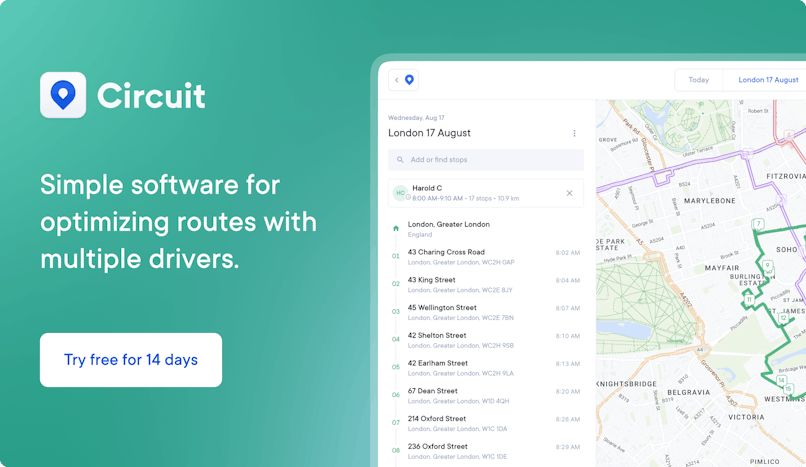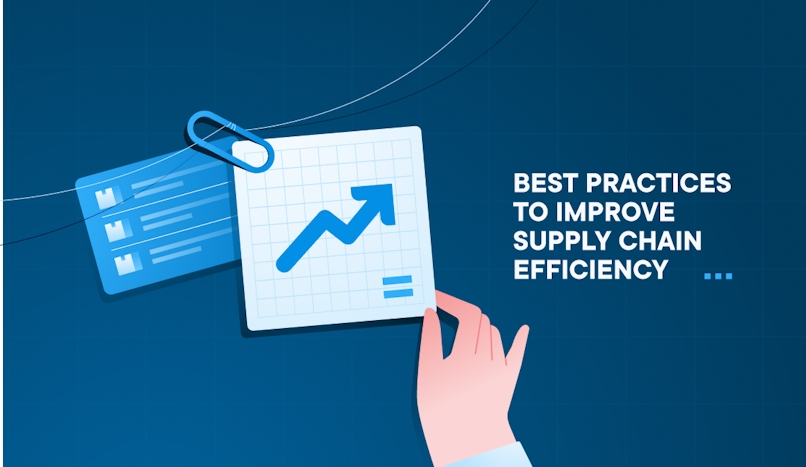9 Best Practices To Improve Supply Chain Efficiency
Discover the most current best practices for supply chain efficiency to save your business time and money.

Optimizing your delivery routes with Circuit for Teams is an easy way to boost your supply chain efficiency.
Every step in your supply chain holds the potential to elevate your business from the status quo to greatness.
An efficient supply chain is where those details come to life, shaping your operations and improving the customer experience.
This article will unravel the importance of a streamlined supply chain and look into practical strategies for improving its efficiency.
From optimizing logistics and inventory management to implementing new technology and strengthening supplier relationships, I’ll offer you actionable steps to unlock the true potential of your entire supply chain, revolutionize your operations, and boost your bottom line.
Key takeaways
- A smooth, organized system that manages the flow of goods from the source to your end customer will help you achieve an efficient supply chain.
- An efficient supply chain can reduce your costs, improve how you use your resources, and make your inventory management more efficient, resulting in better customer service and a healthier bottom line.
- Using automation and real-time supply chain visibility data optimizes your logistics and keeps your supply chain strategy ahead of the curve.
- Measuring supply chain performance using key metrics and industry benchmarks will help you identify areas for improvement and assess your supply chain’s efficiency, giving you a competitive advantage.

What does it mean to have an efficient supply chain?
An efficient supply chain means having a well-organized and smoothly running system that manages the flow of goods and services from the source to the end customer.
Supply chain efficiency is all about minimizing waste, reducing operational costs, and increasing productivity. This leads to improved customer satisfaction and more profit for your business.

9 best practices to improve supply chain efficiency
Implementing these best practices can make your supply chain more efficient, cut costs, exceed customer expectations, and position your business for success.
1. Emphasize effective logistics management
Effective logistics management solutions include optimizing transportation routes to reduce transit time and costs. This might include putting systems in place to streamline the movement of goods (cross-docking, for example), and tracking your shipments in real time.
You can also use software to manage and coordinate your logistics operations. Circuit for Teams is one of the many tools available for this is. Circuit for Teams can help you make deliveries faster and more efficiently with automatic route optimization and real-time driver tracking.
2. Improve supply chain visibility
Supply chain visibility means having real-time access to accurate information about your inventory, orders, and shipments at every stage.
This lets you anticipate lead times and identify potential issues like bottlenecks or shortages, which can inform your decision-making and prevent delays.
You can achieve better supply chain visibility by implementing new technology and integrating your logistics systems.
3. Optimize inventory management
Effective inventory management takes a balance of carrying enough inventory to meet customer demands, minimizing excess stock, and avoiding stockouts.
You can optimize inventory levels, reduce holding costs, and improve overall efficiency by implementing just-in-time (JIT) inventory management, demand forecasting, and inventory tracking systems.
4. Develop supplier relationships
Building solid supplier relationships is key to a smooth and efficient supply chain.
Close collaboration with your suppliers helps maintain timely deliveries of raw materials, better quality control, and even cost savings through mutually beneficial relationships.
Encourage open communication, establish trust, and explore opportunities for partnerships with reliable suppliers to enhance your supply chain's efficiency.
5. Automate
Automation can significantly boost your supply chain efficiency by reducing manual tasks (and human errors) and improving productivity.
Consider implementing automation technologies, such as barcode scanning, automated order processing, and robotic process automation (RPA), to streamline your supply chain operations.
This can free up your employees' time to focus on their most important tasks and keep your business competitive in today's fast-paced market.
6. Use real-time data
Real-time supply chain data gives you valuable insight into your supply chain operations. You can use technologies like Internet of Things (IoT) sensors, cloud-based analytics, and data visualization tools to see where your supplies and inventory are (and in what quantities) at any given time.
This helps you make data-driven decisions, pinpoint supply chain inefficiencies and disruptions, and optimize your processes as needed.
7. Invest in employee development
Your employees are valuable assets in achieving supply chain efficiency.
Invest in their professional development with training, education, and opportunities to enhance their skills. This can improve productivity, spark innovation, advance supply chain planning, and create a culture of continuous improvement in your organization.
8. Optimize the returns management process
Whether you need to return faulty materials to your supplier or a customer wants to return a product you sold them, returns are an inevitable part of any supply chain.
Optimizing the returns management process involves developing streamlined procedures for handling product returns, assessing returned items for resale, repair, or disposal, and implementing efficient reverse logistics.
Effectively managing your returns can help you minimize costs, improve customer satisfaction, and reduce the impact of returns on your overall supply chain efficiency.
9. Measure and improve your processes
Continuous improvement is essential for maintaining supply chain efficiency.
Regularly measure key performance indicators (KPIs) related to your supply chain processes and use that data to identify areas for improvement.
Implement process improvement initiatives, such as Lean Six Sigma or Kaizen, to eliminate waste, streamline operations, and increase efficiency.

Metrics for measuring supply chain efficiency
Measuring supply chain efficiency will help you identify areas of improvement and assess your supply chain’s performance.
Here are some key metrics and approaches you can use to measure and evaluate your supply chain’s efficiency:
- Order fulfillment cycle time: This metric measures the time period from when you get a customer’s order to when they get it. A shorter cycle time is a sign of efficiency, since it indicates faster order processing and fulfillment.
- On-time delivery: This metric tracks the percentage of orders delivered to customers within the promised time frame. High on-time delivery rates indicate a reliable and efficient supply chain.
- Perfect order rate: This metric measures the percentage of orders fulfilled accurately, without errors or discrepancies. A high perfect order rate indicates an efficient supply chain that minimizes mistakes and customer dissatisfaction.
- Inventory turnover: Inventory turnover measures how quickly your inventory is sold and replenished. It reflects your inventory management's efficiency and whether you’re maintaining optimal inventory levels. Higher turnover rates generally mean better supply chain efficiency.
- Cash-to-cash cycle time: Also known as the cash conversion cycle (CCC), this metric measures the time it takes for your business to convert cash investments into revenue — the shorter the cycle, the better. It considers the time taken to pay suppliers, the time inventory sits in your warehouse, and the time it takes to collect customer payment.
- Supplier performance metrics: Your suppliers’ performance directly impacts your supply chain. Key metrics to measure include suppliers’ on-time delivery rates, the quality of those goods, and suppliers’ responsiveness when you have issues or need changes.
- Transportation costs: Analyzing transportation costs as a percentage of your total logistics costs tells you a lot about the efficiency of your transportation operations. Lower transportation costs relative to your overall logistics costs suggest that you’re managing your transportation sources well.
- Warehousing and storage costs: Monitoring the costs of your warehousing and storage facilities can also tell you how efficient your inventory management and storage practices are. Higher costs may stem from issues like excess inventory, poor space utilization, or inefficient picking and packing processes.
- Return on investment (ROI): Calculating the ROI of your supply chain initiatives and investments is an important part of understanding your business’s profitability. It helps you figure out how effective your efforts are so you can prioritize future investments accordingly.
How can you effectively measure supply chain efficiency?
Implementing supply chain management systems and using new technologies, such as data analytics, real-time tracking, and automated reporting, can help you collect and analyze the data you need to find out if your supply chain is running smoothly. So can comparing your performance to that of your peers and industry standards.
Remember, supply chain efficiency is an ongoing pursuit. Regularly reviewing and analyzing these metrics, identifying trends, and implementing continuous improvement initiatives based on these insights are surefire ways to optimize your supply chain and stay competitive.
Managing deliveries yourself? Circuit for Teams can help improve your supply chain efficiency
A Circuit for Teams delivery is efficient from start to finish. The platform lets you swiftly plan, optimize, and assign routes. It comes with live tracking and route management features to seamlessly adapt to any last-minute changes.
For drivers, it offers an easy-to-follow app that saves time and fuel and lets them effortlessly capture proof of delivery in seconds. Even your customers will love the delivery experience with automatic customer notifications that offer accurate ETAs and tracking details, reducing the likelihood of a missed delivery.
Enhance your supply chain efficiency by optimizing your deliveries today with the power of Circuit for Teams.




